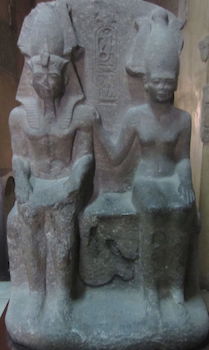
Anat (also known as Anant, Anit, Anti, Anthat and Antit) was an ancient Canaanite deity who became popular in ancient Egypt towards the end of the Middle Kingdom. She was particularly popular in the northern delta area during the Second Intermediate period (the Hyksos period) but her worship suggests that there had been a slow migration of people from the levant for some time before the Hyksos invasion.
Although the Pharaohs of the New Kingdom were hostile to the Hyksos culture, she was not rejected when the Hyksos were repelled and Egypt was reunified under Amose I. In fact, Ramesses II adopted Anat as his personal guardian in battle and expanded the shrine to Anat when he undertook the restoration of Tanis. He also named his dog “Anat in vigor” and had a daughter (who later became his wife) called “Bint-Anat” (“Daughter of Anat”).



Anat was a goddess of fertility, sexual love, hunting and war, and as such was rather a paradoxical deity. She was considered to be the mother of the gods, but was also known as “the Virgin”. She was sometimes known as “the Wanton” (because of her lust for sex and war), the Fairest daughter-sister of Baal, “the Lady”, “the Destroyer”, “Strength of Life”, and “the Lady of the Mountain”. She also had a number of epithets which seem to have been peculiarly Egyptian, most notably “Anat-her” (“Agreeable Anat”), “Herit-Anta” (“Terror of Anat”) and around Elephantine (first nome of Upper Egypt) the hebrew “Beth-El” (“House of God”).
The cuniform texts describe her as an aggressive and ruthless goddess who destroys the enemies of Baal and wades through pools of their blood. She even hunts down and kills Mot (death) when he slays Baal. However, she also had a more gentle side. As a goddess of sexuality she was considered to be the most beautiful of all of the gods, and as a fertility goddess she protected the people, animals and the crops.
She was originally considered to be the daughter of El, and the sister and wife of Baal. In Egypt she was regarded as the daughter of Ra and the wife of Set (who was associated with Baal) along with her sister Astarte. However, in Memphis she was also thought to be the daughter of Ptah, and the Hebrew workers of the eighteenth dynasty (New Kingdom) considered her to be the wife of Andjety, who was associated with Osiris.
The Egyptians also linked her with Neith (a war goddess from the Delta who was associated with weaving). Like Neith, Anat was often depicted bearing either a spear or a spindle. She was also associated with the precious dye known as Tyrian Purple (which despite the name was sometimes almost blood red in colour) and the murex snail from which the dye was made.
She was worshipped in Memphis with all of the major gods and goddesses, but also had shrines in Tanis (the Hyksos capital) and Beth-Shan (in Palestine). Anat was also worshiped in the Temple of Yahweh by the Jewish settlers on the island of Elephantine.
The Phoenecians generally depicted Anat as a naked woman with exaggerated sexual organs bearing a bow and arrow (sometimes exchanged for a spear or a weaving spindle). She was often accompanied by a lion, her sacred animal. In Egypt she was frequently given a plumed crown which resembled the White Crown and carried either a spear, battle axe and shield or a scepter and an Ankh.
Bibliography
- Bard, Kathryn (2008)An introduction to the Archaeology of Ancient Egypt
- Goodenough, Simon (1997) Egyptian Mythology
- Lesko, Barbara S (1999) The Great Goddesses of Egypt
- Pinch, Geraldine (2002) Handbook Egyptian Mythology
- Redford Donald B (2002) Ancient Gods Speak
- Watterson, Barbara (1996) Gods of Ancient Egypt
- Wilkinson, Richard H. (2003) The Complete Gods and Goddesses of Ancient Egypt
copyright J Hill 2010